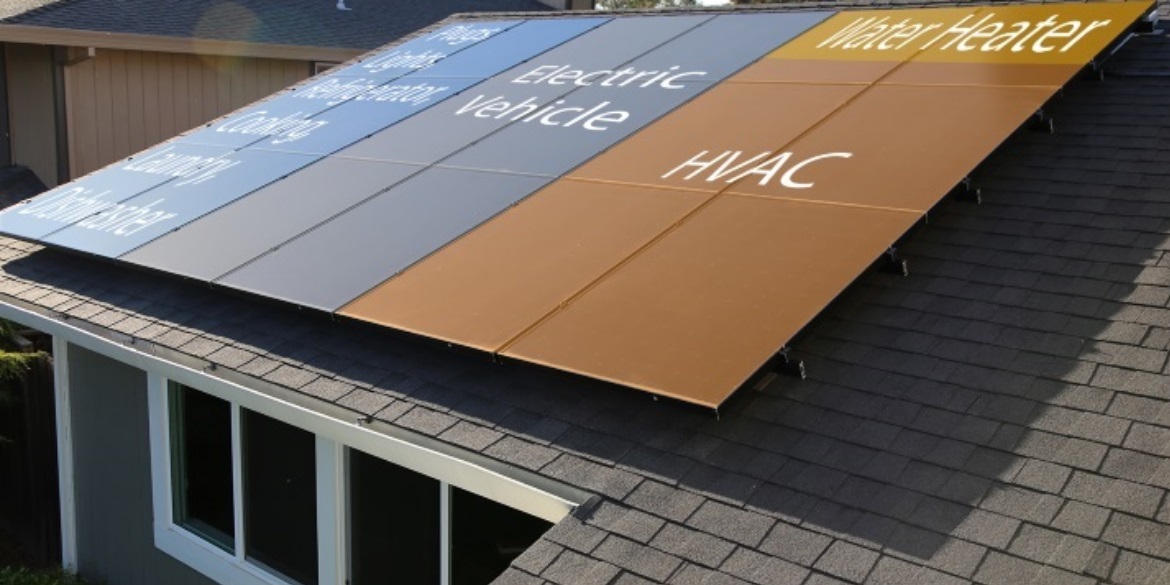This is the second article of an 11-part series on Solar+ homes. The series describes how homeowners can combine simple energy efficiency measures, solar PV, electric vehicles and appliance electrification to create households that are fully powered by solar electricity—even in existing homes. A Solar+ home provides substantial economic and environmental savings to the homeowner, and creates load profiles that are low-cost for utilities to serve.
What is a Solar+ home?
Existing clean energy technologies can be cost-effectively combined to result in a Solar+ home that offers strong economic and environmental benefits. The approach is to combine solar photovoltaic (PV) power, an electric vehicle (EV), simple energy efficiency measures and appliance electrification. Benefits are maximized when the various technologies are sized, installed and operated within the context of the house as an integrated system.
The specific technologies are:
- Solar power, where PV is located either on the customer’s home or as community solar.
- Personal transportation electrification that shifts from gas-powered vehicles to EVs.
- Simple energy efficiency measures, including phantom (or plug) load reduction and conversion to LED lighting.
- Appliance electrification, including conversion of water and space heating from natural gas to electric heat pump technologies.
- Basic building shell improvements including caulking, targeted insulation and ventilation.
Conceptual Example of Solar+ Home
Figure 1 illustrates how to convert a typical home to a Solar+ home. The size of the rectangles represent the amount of site energy consumed, normalized into units of kWh. The left graph is the existing situation. The middle graph corresponds to the amount of energy consumed after efficiency, an EV and electrification. The right graph shows how the electricity consumption is satisfied using PV.
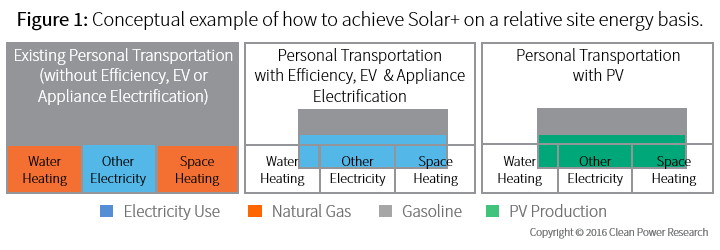
The large rectangle in the left graph (Existing situation) corresponds to the total amount of site energy required before conversion. The four inset boxes represent the sources of consumption including: Personal Transportation, Water Heating, Space Heating and Other Electricity. The relative sizes of the rectangles are drawn to scale and correspond to site energy. The colors correspond to the fuel sources including: electricity (blue), natural gas (orange) and gasoline (gray).
The middle graph shows how site energy is reduced by:
- implementing efficiency and switching gasoline-powered vehicles to a hybrid and an electric vehicle; and
- switching natural gas-powered water and space heating to electric-powered appliances.
The right graph shows how electricity consumption can be supplied using PV power. That is, the PV production (green) is overlaid on top of the electricity consumption (blue) so that net electricity consumption is zero.
There are a few things to notice:
- Personal Transportation in the Existing graph accounts for more than half of the energy consumption.
- Other Electricity in the Existing graph (and the typical target for a PV system) only represents one-seventh of the total site energy consumption.
- Consumption is greatly reduced using basic efficiency measures, an EV and appliance electrification (middle graph).
- Consumption can be met by a moderately sized PV system (right graph) to almost eliminate site energy consumption.
Some gasoline consumption remains because only one of the household’s two vehicles is electrified. If carbon dioxide (CO2) emissions were used instead of site energy consumption in the graphs, the only remaining emissions would be those associated with the gasoline used by the gas-powered vehicle. There would be about a 90 percent reduction in emissions.
Actual Example of Solar+ Home
Conceptual diagrams are interesting but what people really care about is whether or not Solar+ homes are feasible in practice.
Clean Power Research has had a multi-year research effort focused on Solar+ homes. Part of the effort was to cost-effectively implement Solar+ in an existing, fully occupied house using off-the-shelf technology without a deep retrofit. The prototype house has been operated since May 2014.
Figure 2 presents one year’s worth of measured results. Net site energy consumption has been reduced by 85 percent by combining efficiency investments, appliance electrification and powering electricity consumption with a 5.9 kW PV system. Annual end-use consumption is graphically overlaid on the PV panels to illustrate how much energy each end-use consumed relative to the amount of energy produced by the PV.
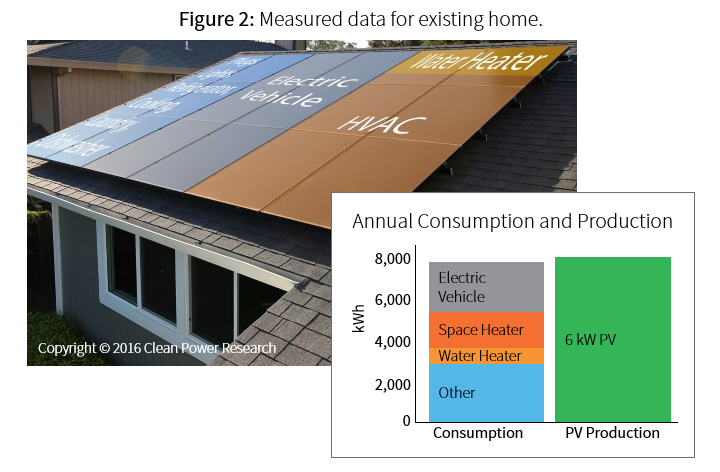
Figures 3, 4 and 5 present average daily energy consumption by month for the last six years. The figures show that:
- Other electricity consumption has declined with phantom load reduction and LED lights.
- Water and space heating consumption has declined with the switch to efficient electric appliances and building shell improvements.
- Transportation consumption has declined with the switch to an EV and a hybrid—even with a 50 percent increase in mileage.
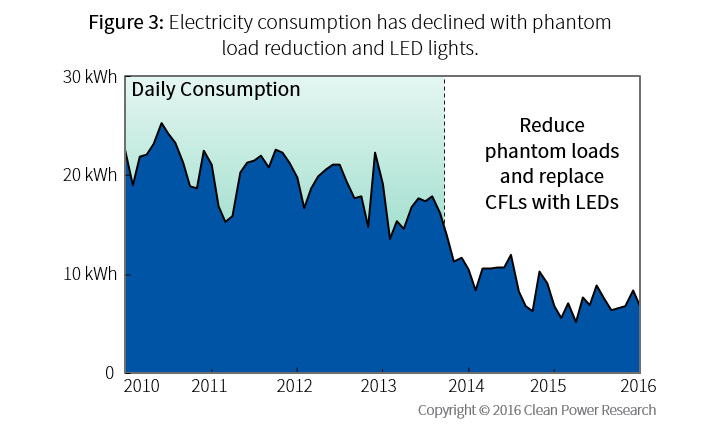
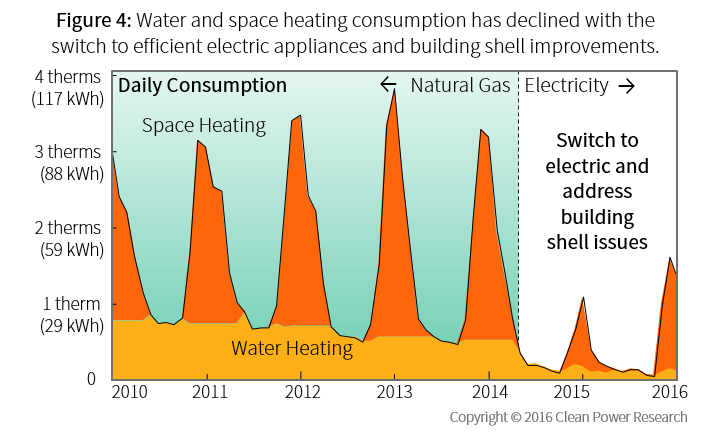
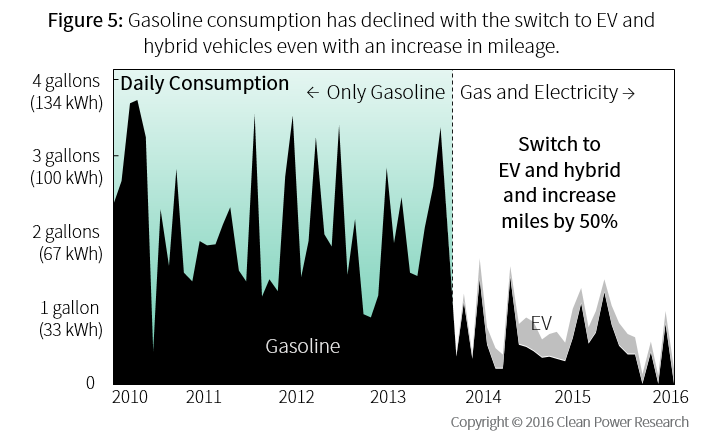
The only remaining non-solar consumption is 200 gallons of gasoline for the gas-powered (hybrid, but not plug-in hybrid) vehicle, and 30 therms of natural gas for clothes drying. Since the home uses electric resistance heating, the final step will be to convert the resistance heating to a mini-split heat pump and purchase an electric dryer. This would save enough electricity that could then be used to fully power a second EV, making the home 100% renewable powered if this were done today. That is, the PV system is already sized sufficiently large enough to reach a fully Solar+ home given the energy savings with a heat pump and the energy consumption associated with a second EV.
Key Takeaway
Clean Power Research has cost-effectively retrofitted an existing house to make it an 85% Solar+ home. The home would be a fully Solar+ home if a long-range EV were commercially available at the same price as a hybrid vehicle. Advanced planning has allowed the PV system to be sized so as to reach a fully Solar+ home given two more investments: switch from electric resistance heating to a heat pump (save about 1,500 kWh per year) and switch from a hybrid vehicle to a second EV (consume about 1,500 kWh per year).
Don’t miss the next article in the series! Subscribe now to receive future updates about Solar+ homes.
To go to the next Solar+ homes article, click here.
To go to the first article in the series, click here.
